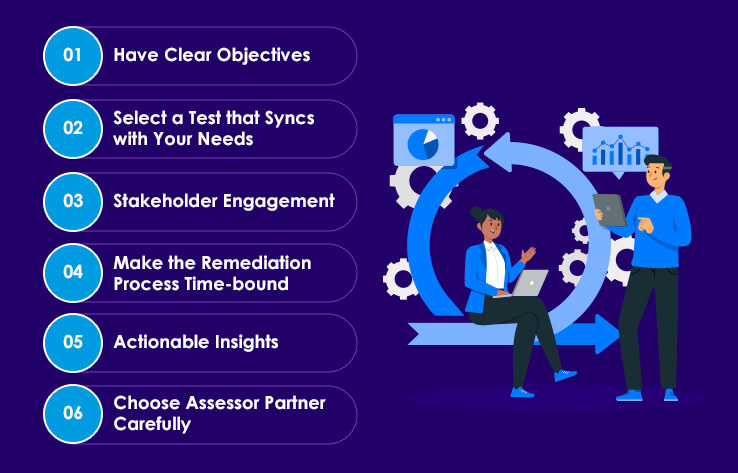- Overview of Agile Maturity Assessment
- Agile Maturity Model and its 5 Levels
- Why is it Necessary to Assess Agile Maturity?
- How to Conduct Agile Maturity Assessment – Best Practices
- Summary
Agile coaches or Scrum masters have a good idea of what it takes for a team to mature. They understand the behaviors that should be shown daily to maximize project value delivery. But the question is, “How to bring the team around? How do we bring awareness and share knowledge about this journey among the team?” The answer to these questions is “agile maturity assessment.” It can help teams understand the basic concept of agile maturity and the steps they should take to reach the top level.
Agile maturity assessments allow businesses to measure their agility regarding technologies, processes, and people. These factors could directly influence their operational efficiency and competitive edge. These assessments allow enterprises to streamline processes, improve business outcomes, and enhance team productivity by identifying weaknesses and strengths.
Overview of Agile Maturity Assessment

Enterprises conduct an agile maturity assessment to evaluate their current state of agile maturity and analyze the value agile implementation has delivered to their organization. They utilize agile maturity models to identify their weaknesses and define goals to align teams efficiently with business changes. According to statistics, businesses that adopted agile practices showed a significant growth of 86% within their software development teams. However, many enterprises are not implementing agile principles and values correctly. Let’s take a look at the core components of an agile maturity assessment:
Process Evaluation:
Businesses assess how well the agile methodology is integrated with their project management and development process. They check for consistency and efficiency of agile processes across multiple teams.
Cultural Alignment:
Agile is a mindset that one must become accustomed to. It is about a methodology that drives cultural change in the team. Businesses evaluate whether their work culture supports agile values like responsiveness, collaboration, and flexibility.
Leadership Engagement:
To ensure the success of agile transformation, top leadership must support and actively drive agile practices. They should measure senior management’s commitment and involvement in promoting and implementing agility.
Tooling and Infrastructure:
Every process requires a proper set of tools. The same is true with agile implementation. This component reviews an organization’s tech and infrastructure to support its agile practices, such as CI/CD systems.
Feedback and Improvement Procedures:
Continuous improvement is a core aspect of the agile process. This assessment component allows businesses to examine how quickly they collect and act on feedback received from stakeholders to improve process outcomes.
Agile Maturity Model and its 5 Levels

An agile maturity model tool/framework categorizes an enterprise’s agility level into five stages. It allows businesses to understand the condition of their current agile practices. By doing so, they can steer towards deeper implementation and refinement. Consider it a pathway that guides an enterprise towards continuous improvement in agility, which is necessary to respond quickly to business challenges and market changes.
There are 5 levels in an agile maturity model. From the initial stage, which is the beginning of agile practices in an organization, to the most advanced optimization stage. The goal is to allow teams to deliver value effectively. It also allows businesses to remain competitive in the dynamic market environment. This is true when we say that a business needs agility to grow. By assessing agility maturity, businesses get fine-tuned practices that improve quality, reduce costs, optimize resource allocation, and decrease the timeframe between the planning and delivery stages.
Now let’s take a quick look at five levels of the agile maturity model:
Initial:
Although teams use agile practices in this stage, they lack a formal and inconsistent structure. They do not have a coherent approach to the agile principle, leading to inconsistent project results.
Managed:
This stage involves analyzing the benefits of agile methods as organizations run towards a more systematic approach. The leadership team and agile coaches formalize the processes and focus on project management frameworks to incorporate agile values.
Defined:
In this stage, enterprises have successfully integrated and standardized agile methodologies. All the processes are clearly defined, and teams strongly cater to documentation and maintain a consistent approach to agile practices.
Quantitatively Managed:
At this level, organizations utilize metrics and KPIs to measure the effect of their agile practices. This data-driven approach enables accurate process management and targeted improvements based on quantitative results.
Optimizing:
This is the highest maturity level, focusing on continuous improvement. The organization must follow, innovate, and optimize agile practices continuously. It involves refining methodologies according to changing business and technical ecosystems, ensuring that agility is at the core of enterprise culture.
Why is it Necessary to Assess Agile Maturity?

“At regular intervals, teams have to reflect on how to become more effective, then optimize and adjust their approach accordingly.”- The Agile Manifesto
The majority of organizations (software development, infrastructure management, etc.) are already implementing agile methodology in one way or another. However, the problem is that most enterprises are not using the agile principle and its values accurately. Secondly, many enterprises attempt to become agile, but they keep failing. The problem is that many businesses don’t understand their current state, processes, and employees. The solution to this problem is agile maturity assessment.
Assessment is often termed critique or judgment, which is not true. It reflects a team’s performance and whether it aligns with agile framework practices. Agile maturity assessment clearly shows what’s working for a company and what needs changes. It assists scrum teams in becoming more agile by adopting the values and principles defined in the Agile Manifesto.
Agile transformation is a complicated process that takes a long time for a team to fully agile. A team must understand where it tries to reach in its agile journey. This is why a company or a team must assess/measure their progress, determine their agile path, and define the steps to reach their goals. An agile team assessment would serve as proof of their progress.
How to Conduct Agile Maturity Assessment – Best Practices

An effective agile maturity assessment requires a strategic approach to analyze current practices and set the stage for future improvements. Businesses should be able to identify the effectiveness of their agile methodologies and the next steps they require to advance to the next level of agile maturity. To assist in this, there are certain practices that businesses should follow, which are given below:
Have Clear Objectives:
Clearly define what you want to achieve with the assessment. Set clear goals, focus on specific agility areas, and assess every aspect critical to business success.
Select a Test that Syncs with Your Needs:
One suggestion: Do not use the scrum maturity assessment and model if you are not into the scrum. The framework you choose will help establish a benchmark to keep track of your business progress. So, it becomes your responsibility to select the standard that fits your business ecosystem.
Stakeholder Engagement:
From the start, involve all the stakeholders (leadership team, team members, client (based on project), etc.). Take their input and feedback to gain a diverse perspective to support the assessment.
Make the Remediation Process Time-bound:
Similar to OKRs (objectives and key results); the remediation process should be time-bound based on quarterly deadlines. Select one or two goals that need improvement and monitor them consistently. Keep your improvement process small and enable your team to stay focused.
Actionable Insights:
The assessment should include actionable insights and metrics. Based on the assessment results, implement practical steps to improve agile practices.
Choose Assessor Partner Carefully:
It is crucial to select the right partner, like Tx, for agile maturity assessment. The partner must be knowledgeable, have technical experience, be objective, and be collaborative. This will enable you to look at things differently and easily identify blind spots and biases.
Summary
Agile maturity assessments are crucial for businesses aiming to optimize their agile practices effectively. As a business owner, it becomes your responsibility to measure your agility state and identify your strengths and areas for improvement. It would be more beneficial and deliver expected outcomes when teams follow key practices such as effective communication, collaboration, and the mindset to accept change.
Want to improve your capability to adapt to change? Contact our agile experts and learn how to optimize your tools and processes. Get in touch with us to learn about your business’s current agile state and quickly assess your workflow and processes. Our assessment approach will assist in benchmarking the agile engineering process and ensure continuous improvement in your entire workflow from the initial to the final stage.
The post Conducting an Agile Maturity Assessment: Best Practices first appeared on TestingXperts.






